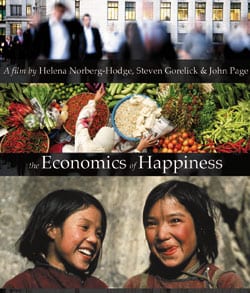Economics of Happiness
The new documentary “The Economics of Happiness” draws attention to the ills of globalization in both the developing and 
The first half of “The Economics of Happiness” highlights the negative impacts of globalization with a particular focus on Ladakh, a remote Indian region located high on the Tibetan plateau. The second half offers examples of successful localization initiatives such as La Via Campesina, an international peasant association, and Transition Towns, a community-led organization focused on strengthening local economies that originated in England.
Norberg-Hodge arrived in Ladakh in 1975 just as the Indian government was opening the region to foreign imports, global media, tourism, and western education. She witnessed first-hand the impact of western-style economic development on a native culture that had been previously sealed off from the rest of the world. Her visual cues of the changes are highly evocative and elicit empathy from the viewer. At the beginning of her visit, the people she lived amongst appeared happy, with a strong sense of community and a deeply rooted cultural identity. Local resources met all of their basic needs. However, under pressure to modernize, the community developed a cultural inferiority complex. Ladakh was exposed to Western media, offering images of glamorized lifestyles quite different from those of its citizens. Incoming tourists spent vast sums of money in contrast to the people of Ladakh who had little disposable income. Schools were opened with Western curriculums that failed to teach the self-sufficiency life skills that had traditionally been passed from generation to generation. Suddenly, home electrical power and foreign imports were much in demand.
When Norberg-Hodge first arrived in Leh, Ladakh’s capital, herds of cows caused traffic congestion and farms were visible from the center of the town. Twenty years later, Leh was an urban sprawl. The streets were clogged with cars, housing projects spread out into the desert, and the air and water was polluted. Society was divided by age, gender, wealth, and education because family and community ties had been broken. Norberg-Hodge offers up a reversion to a rather simple form of localization as the solution to the societal ills wrought by the forces of global capital in places like Ladakh — meeting community needs as locally as possible through community-based production.
Economic thinker and urban activist Jane Jacobs also maintained that the well being of communities depends on internally generated economic growth. However, in her vision, a robust and resilient local economy resulted from a far more complex and dynamic interaction with the larger world. From Jacobs’ perspective, there are two primary drivers of economic development: import-replacement and exports. In her view, a settlement initially engages in export trade, and fulfills many of its needs by importing goods from elsewhere. Excess capital earned from exports is then invested in producing those previously imported goods locally. Import-replacement minimizes money spent on purchasing previously imported goods and services, creates local employment and products, and retains capital within the community. Over time, the capacity to replace imports exceeds local needs and locally produced goods and services are, in turn, exported resulting in a dynamic feedback loop, or trade, that drives economic development.
Although Jacobs clearly supports localization, her focus on the necessary exchange of imports and exports across local, regional, national, and global markets underscores how local economies are inextricably linked to the world-at-large. It is exactly that failure to place developing economies in a broader regional and global framework that has led some to be critical of the forms of relocalization that Norberg-Hodge appears to champion in “The Economics of Happiness.”
Ladakh was closed off from the rest of the world for centuries. When it was finally opened up, its citizens desired a different standard of living. The failure to embrace the economic development that comes with globalization is like using a telephone as a paperweight instead of a communication device that connects to the outside world. Norberg-Hodge’s “localization” deemphasizes the importance of remaining open to the world and the export opportunities that openness offers. “Localization” is crucial to Jacobs’ “import-replacement,” in that small regional businesses each build parts to create the products that serve community needs. For an economy to be self-sustaining and to develop with growing needs, new energy must be brought in and used energy let out. Open local economies are in effect more resilient, since production costs and surplus product are able to be absorbed by external populations, enabling the continuing production of new goods for sustainable economic growth. Globalization is an inevitable result of economic growth over time and it is ubiquitous at this stage in economic history.
The Capital Institute takes the view, as Jacobs did, that appropriate economic growth must be modeled on, and constrained by, natural systems. Norberg-Hodge exposes viewers to the natural beauty of the East, and reminds us to value culture and community in her compelling argument for what constitutes true wealth building. Problematically, today’s global economy, driven by rampant, unconstrained economic growth requires redirection via a more complex strategy than that proposed by Norberg-Hodge to ensure the transition to “a more socially and ecologically resilient economy.” —Liana Scobie. Liana is fellow of the Capital Institute.

